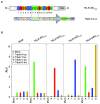ULtiMATE system for rapid assembly of customized TAL effectors
- PMID: 24228087
- PMCID: PMC3815405
- DOI: 10.1371/journal.pone.0075649
ULtiMATE system for rapid assembly of customized TAL effectors
Abstract
Engineered TAL-effector nucleases (TALENs) and TALE-based constructs have become powerful tools for eukaryotic genome editing. Although many methods have been reported, it remains a challenge for the assembly of designer-based TALE repeats in a fast, precise and cost-effective manner. We present an ULtiMATE (USER-based Ligation Mediated Assembly of TAL Effector) system for speedy and accurate assembly of customized TALE constructs. This method takes advantage of uracil-specific excision reagent (USER) to create multiple distinct sticky ends between any neighboring DNA fragments for specific ligation. With pre-assembled templates, multiple TALE DNA-binding domains could be efficiently assembled in order within hours with minimal manual operation. This system has been demonstrated to produce both functional TALENs for effective gene knockout and TALE-mediated gene-specific transcription activation (TALE-TA). The feature of both ease-of-operation and high efficiency of ULtiMATE system makes it not only an ideal method for biologic labs, but also an approach well suited for large-scale assembly of TALENs and any other TALE-based constructions.
Conflict of interest statement
Figures



References
Publication types
MeSH terms
Substances
LinkOut - more resources
Full Text Sources
Other Literature Sources
Miscellaneous

